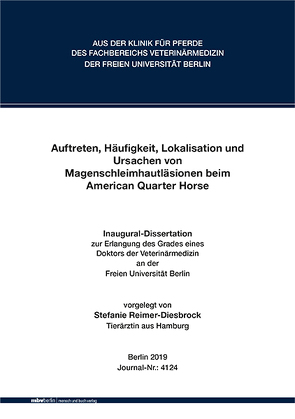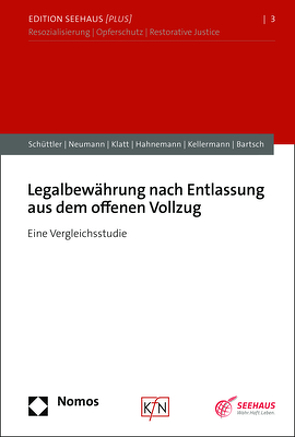Bisher mangelt es an kontrollierten Untersuchungen zum Effekt des offenen Vollzugs auf die Legalbewährung, da vorherige Studien unterschiedliche Gruppen von Inhaftierten miteinander verglichen. Um diesem Selektionseffekt entgegenzuwirken, wurden in der vorliegenden Studie mittels Matching-Verfahren vergleichbare Gruppen von Gefangenen gebildet. Mit Hilfe von Bundeszentralregisterdaten konnten die Rückfallquote, -geschwindigkeit und -schwere untersucht sowie individuelle Risiko- und Schutzfaktoren der Gefangenen kontrolliert werden. Die Ergebnisse zeigen, dass die Unterbringung im offenen Vollzug über die Positivauswahl von Gefangenen hinaus einen eigenständigen Effekt hat und das Risiko einer erneuten Inhaftierung signifikant reduziert.
Aktualisiert: 2023-05-17
> findR *

Affections of the stomach mucosa are common diseases in horses. The prevalence of equine gastric ulcer syndrome (EGUS) varies with breed, use, training and localisation of the lesions between 11% and 100%. Affected horses often show unspecific or no clinical signs at all. The majority of studies has been carried out with Thoroughbred racehorses. The aim of this study was to explore another widespread horse breed with a different usage. The American Quarter Horse was chosen because of its different temperament and use. Apart from the prevalence, localisations and severity of lesions as well as risk factors for EGUS from the management and feeding should be identified.
For this study, 48 horses were examined. With 38 of the 48 horses a second examination was carried out. The examinations were conducted once in summer and once in winter. The horses had been housed for a minimum of four weeks in the typical summer or winter stable. All horses were not on any medical treatment. A quastionnaire including patient information, management, feeding, workload and character of the horse was answered by the owners. Gastroscopies were performed in the stables the horses were housed in. The anamnesis and the results of the examination were documented in a findings sheet. The diagnosis of the stomachs mucosa was based on the scoring system with five grades of ANDREWS et al. (1999), which is recommended by the Equine Gastric Ulcer Council (EGUC). An ulceratiomn score of ≥2 was regarded as being clinical significant. The findings in the glandular mucosa are not evaluated with this system, so that we developed a system with five grades for this part of the stomach to get comparable results.
In 79% of the examinations the horses had alterations in the squamous mucosa of which 57% were regarded as being clinical relevant. The glandular mucosa was affected in 59% of the examinations. Both mucosa components simultaniously were affected in 43%. In 53% of the cases the lesions were located along the margo plicatus, in 56% of the cases near the lesser curvature, in 29% of the cases around the cardia and in 48% of the examinations at the pylorus. There was no case in which the Saccus caecus ventriculi or the oesophagus were affected.
Alterations of the squamous mucosa were graded as 2 in 40% of the cases, 17% of the horses had more severe lesions. Findings in the glandular mucosa were scored with 1in 40% of the examinations, 20% of the cases were scored as 2 or 3. In total, the alterations in the squamous mucosa were scored more severe than the lesions in the glandular mucosa.
In this population, female horses were less affected than male horses. Horses housed in the country had a lower risk for EGUS than horses kept near or in cities. If the horses were housed in a city, the risk for EGUS increased significantly. Free access to fibrous feed and hay fed for the first meal of the day reduced the morbidity rate, as well as a low pH in the gastric juice. Horses in active western performence had a higher morbidity rate than horses that did not take part in competitions.
The data of performance horses in this population were analyzed seperately because of the great relevance of performance for this disease. A high starch intake, a status as a „friend“, a friendly character and perforemance in pleasure or horsemanship/showmanship events raised the morbidity rate. A calm temperament of the horses reduced the morbitity rate.
The data of all examinations were analyzed seperately for the squamous and glandular mucosa and the season. In summer, the squamous mucosa was frequently affected if the horses were fed with concentrate for the second meal, housed on straw, had a BCS of six or a high bodyweight. A high proportion of galopp in the training and an increasing time spend in contact with humans also exacerbated the morbidity rate. A very good appetite and pasture turnout reduced the risk for EGUS. The glandular mucosa was frequently affected if the horses were used for amateur or professional performance, used as leisure or sporthorses or showed at western events. Time spend with humans also raised the risk for alterations of the glandular mucosa. In contrast, feeding oat lowered the morbidity rate. Both mucosa components simultaniously were more often affected if the horses showed a very good appetite, if they were transported und if they were showed at western events. As seen for the glandular mucosa, the morbidity rate was lowered by feeding oat.
In winter juice feed, concentrate for the second meal, daily exercise and a high percentage of galopp in training raised the morbidity rate for the squamous mucosa. It was lowered by feeding roughage for the first meal of the day. Feeding concentrate for the second meal also raised the risk for alterations of the glandular mucosa. Both mucosa components simultaniously had a lower morbidity rate if roughage was fed for the second meal.
The results of this study show that the prevalence of clinical relevant endoscopic findings in this study was in the range of the prevanlences found in performance- and leisure horses. But it was noticable above the 40% found in performing American Quarter Horses. The localisation of lesions are comparable with the findings described in other studies. The assumed risk factors for EGUS can also be found in the examined American Quarter Horse population. Feeding roughage, pasture turnout and housing in the country for example lowered the risk for alterations of the gastric mucosa. Training and participation in competitions raised the morbidity risk. For the glandular mucosa fewer risk factors were identified in this study than for the squamous mucosa. Further studies should focus on the glandular mucosa to identify the causes for alterations in this area. Therfore an international standardsystem for the scoring of lesions in both parts of the gastric mucosa is needed.
As a result from this study, the influence of social aspects on the gastric mucosa is of particular note. A friendly character, the social status of a friend and an increasing time spend in contact with humans were associated with the ulcer grade. These perceptives identify a new approach for the exploration of the aetiopathogenesis of EGUS. The contact with humans as an influential factor on the development of lesions of the gastric mucosa should be examined more closely.
Aktualisiert: 2022-12-31
> findR *
MEHR ANZEIGEN
Bücher zum Thema protective factors
Sie suchen ein Buch über protective factors? Bei Buch findr finden Sie eine große Auswahl Bücher zum
Thema protective factors. Entdecken Sie neue Bücher oder Klassiker für Sie selbst oder zum Verschenken. Buch findr
hat zahlreiche Bücher zum Thema protective factors im Sortiment. Nehmen Sie sich Zeit zum Stöbern und finden Sie das
passende Buch für Ihr Lesevergnügen. Stöbern Sie durch unser Angebot und finden Sie aus unserer großen Auswahl das
Buch, das Ihnen zusagt. Bei Buch findr finden Sie Romane, Ratgeber, wissenschaftliche und populärwissenschaftliche
Bücher uvm. Bestellen Sie Ihr Buch zum Thema protective factors einfach online und lassen Sie es sich bequem nach
Hause schicken. Wir wünschen Ihnen schöne und entspannte Lesemomente mit Ihrem Buch.
protective factors - Große Auswahl Bücher bei Buch findr
Bei uns finden Sie Bücher beliebter Autoren, Neuerscheinungen, Bestseller genauso wie alte Schätze. Bücher zum
Thema protective factors, die Ihre Fantasie anregen und Bücher, die Sie weiterbilden und Ihnen wissenschaftliche
Fakten vermitteln. Ganz nach Ihrem Geschmack ist das passende Buch für Sie dabei. Finden Sie eine große Auswahl
Bücher verschiedenster Genres, Verlage, Autoren bei Buchfindr:
Sie haben viele Möglichkeiten bei Buch findr die passenden Bücher für Ihr Lesevergnügen zu entdecken. Nutzen Sie
unsere Suchfunktionen, um zu stöbern und für Sie interessante Bücher in den unterschiedlichen Genres und Kategorien
zu finden. Unter protective factors und weitere Themen und Kategorien finden Sie schnell und einfach eine Auflistung
thematisch passender Bücher. Probieren Sie es aus, legen Sie jetzt los! Ihrem Lesevergnügen steht nichts im Wege.
Nutzen Sie die Vorteile Ihre Bücher online zu kaufen und bekommen Sie die bestellten Bücher schnell und bequem
zugestellt. Nehmen Sie sich die Zeit, online die Bücher Ihrer Wahl anzulesen, Buchempfehlungen und Rezensionen zu
studieren, Informationen zu Autoren zu lesen. Viel Spaß beim Lesen wünscht Ihnen das Team von Buchfindr.

